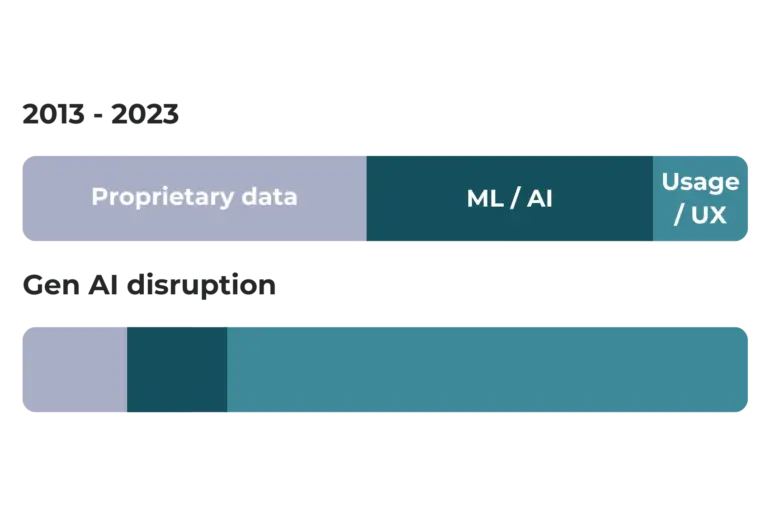Insurtech in the Gen AI era: the end of the Build vs. Buy Dilemma


Writer: Christophe Bourguignat , CPTO
Insurance companies that want to innovate and be performant do face a pivotal decision since the recent availability of generative AI and foundation LLMs.
Let’s take the example of a picture analysis solution to automate motor claim assessment, or a personalization engine for advanced policyholder experience. Up to now, insurers had the choice between buying off-the-shelf existing solutions, or to embark on the journey of building from scratch. Each approach comes with its own set of advantages and challenges, making the decision a critical one. But in the advent of generative AI and pre-trained, multimodal AI models, this dilemma becomes obsolete and a new path emerges: configuring specialized LLM-first solutions. So let us try to make sense of it!
A- Buying off-the shelf solutions
Insurers are increasingly looking outside for solutions they historically built in-house. The explosion of lightweight APIs, connected point solutions, and the move to the cloud has provided a wealth of options. This shift is driven by the availability of diverse ways to solve problems efficiently, making the decision to look outside more palatable.
1. Speed to market:
One of the key advantages of the ‘Buy off-the-shelf’ approach is the rapid speed at which companies can launch their products. Leveraging pre-built modules and frameworks allows for quicker development cycles, enabling companies to respond swiftly to market demands. Collaborating with a tech-enabling insurtech reduces the time to market significantly—Zelros, for instance, enables insurers to be up and running within 8-12 weeks, a remarkable contrast to the average 3 to 4 years it takes when starting from scratch.
2. Cost efficiency:
By utilizing existing solutions as a foundation, companies can significantly reduce development costs. The availability of plug-and-play components and modules eliminates the need to reinvent the wheel, making it a cost-effective option for startups and established players alike. Typically, Insurtech secured several dozen or hudred million investment to build their platform—a sum far beyond what any insurer could reasonably allocate for a specific application.
3. Industry expertise:
Insurtech solutions that follow the ‘Buy off-the-shelf’ model often come with industry-specific expertise embedded. These solutions are designed with a deep understanding of insurance processes and regulations, providing a solid foundation for customization without sacrificing compliance. Their specialization is unwaveringly dedicated to insurance—they merge technological prowess with domain expertise, recognizing the intricacies and high regulatory standards of this specific business sector.
B- Building from scratch solutions
While opting to build something internally provides control over all aspects of the work, it doesn’t preclude the opportunity to benefit from the lessons of collaboration. Building something and buying something share similar resources, structures, and processes. The positive aspect is that everyone is on the same team, fostering effective collaboration. However, it also introduces constraints like culture and politics that can be critical in determining how collaboration unfolds.
1. Unparalleled customization:
Building a platform from scratch provides unparalleled customization options. Companies have the freedom to design every aspect of their solution to perfectly align with their unique business processes, ensuring a tailor-made fit.
2. Innovation at its core:
For those aiming to push the boundaries of Insurtech, building from scratch fosters a culture of innovation. This approach allows for the integration of cutting-edge technologies and the development of proprietary solutions, setting the stage for industry leadership.
3. Full control:
Companies opting to build from scratch retain complete control over their technology stack. This level of control is crucial for ensuring security, compliance, and the ability to adapt to future technological advancements without constraints.
4. Long-term vision:
Building from scratch is an investment in the long-term vision of the company. While the initial development may take more time and resources, the resulting platform is a unique asset that aligns precisely with the strategic goals and future plans of the Insurtech venture.
C- Configuring highly specialized LLM-first solutions
In the Gen AI era, the advent of Large Language Models (LLMs) is transforming the approach to AI applications in insurtech. This shift marks a departure from traditional methods, emphasizing the unique capabilities of LLMs:
1. Flexibility & scalability:
Configurable solutions offer a balance between flexibility and scalability. Companies can tailor the platform to their specific needs while ensuring that it can grow and adapt as the business expands or pivots. Zelros assigns dedicated customer success teams to each account, fostering collaborative efforts in integrating Zelros and addressing specific needs. This alignment with the client’s strategy goes beyond problem-solving; it’s a shared journey aimed at propelling both organizations forward together.
2. Multimodal capabilities and team dynamics:
LLMs’ ability to process diverse data types, such as voice, images, and structured data, is breaking down the silos of scientific specialization. This evolution is reshaping data teams and elevating the significance of LLMOps, challenging the traditional role of data scientists.
3. Foundation model advantage:
The ‘trained once and for all’ nature of foundation LLMs minimizes the need for exclusive training data or custom models. This shift democratizes AI application development, making advanced capabilities more accessible.
4. Configuration over creation:
The focus with LLMs shifts from creating or using task-specific AI to configuring prompts that deliver business outcomes. This approach emphasizes strategic prompt design to leverage AI effectively.
5. Value redistribution in tech applications:
The balance of value in tech applications is now tilting towards user experience (UX). In this new landscape, UX, powered by generative AI, becomes the key differentiator, elevating the importance of effective design and integration.
6. Rise of specialized B2B SaaS applications:
A new wave of B2B SaaS applications is emerging, centered around market-leading LLMs. These applications prioritize domain-specific configurations, often using low-code/no-code platforms, and focus on seamless UX integration into existing systems.
By configuring highly specialized LLM-first solutions, insurtech companies are navigating a new frontier, leveraging the strengths of generative AI to deliver enhanced, efficient, and personalized insurance services.
Conclusion: the end of the ‘build or buy’ dilemma
As multimodal LLMs and Generative AI become more commonplace, the ‘Build vs. Buy’ debate is effectively settled.
Insurers are unlikely to build or assemble their own low-level foundational LLM models due to the significant investment required. Nor will they purchase AI software that lacks customization and configuration options for their specific needs. Instead, insurers will seek partnerships with a new breed of highly specialized, AI-first tech facilitators enabling their business specialists to configure rich applications, often utilizing low-code or no-code platforms. This approach will allow them to improve their agility, and focus on areas where they can gain a competitive edge: enhancing the efficiency of their employees and the experience of their policyholders.
At Zelros, we are this new category of application. We are The Insurance Copilot™.


